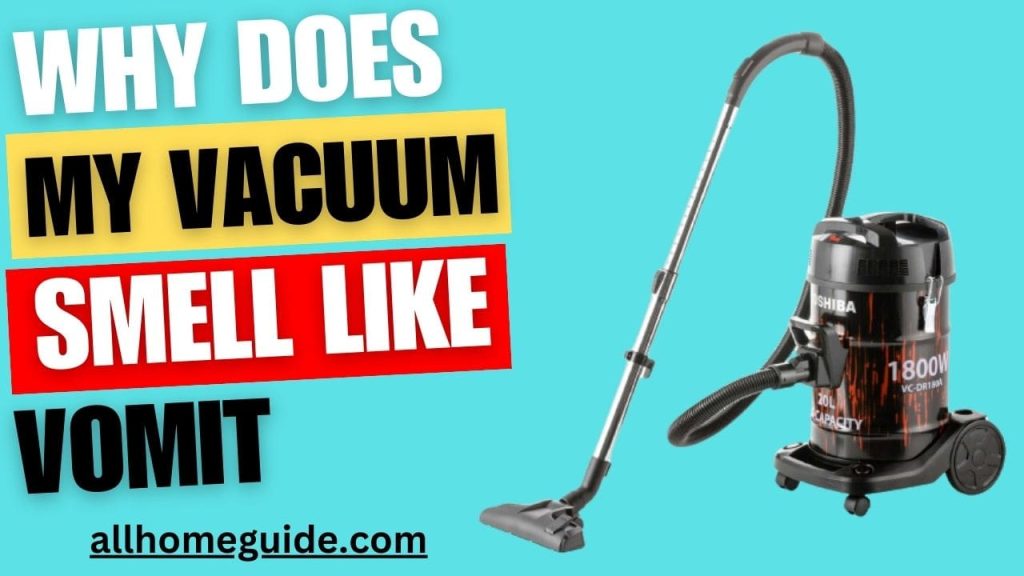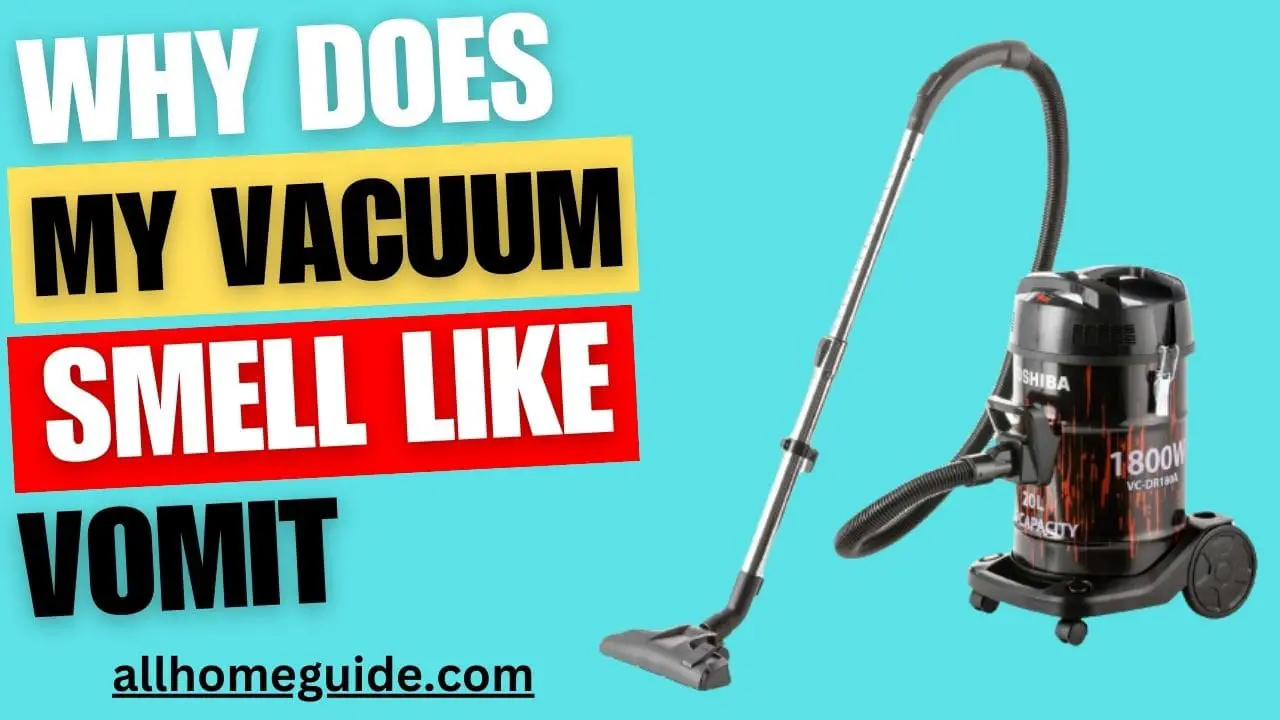We’ve all been there – that cringe-worthy moment when you fire up your vacuum cleaner, and instead of the satisfying hum of a clean home in the making, you’re greeted by a foul odor that’s unmistakably reminiscent. It’s a situation no one wants to face, yet it’s more common than you might think. Your vacuum cleaner, the trusty workhorse of household cleanliness, should be making your home feel fresher, not adding to the problem. So, we will discuss why does my vacuum smell like vomit, and more importantly, how can you get rid of it?
In this comprehensive guide, we’re going to delve into the nitty-gritty of why your vacuum smells like vomit, exploring the various culprits behind this stomach-churning scent and offering practical solutions to eliminate it. Whether you’re a homeowner, a pet owner, or just someone who’s curious about maintaining a clean and odor-free home, this guide is for you.
Let’s embark on this journey to uncover the mysteries of the smelly vacuum and learn how to banish those nauseating odors for good. Because, let’s face it, a home that smells like vomit is no one’s idea of a pleasant living environment.
Understanding the Causes of the Vomit-Like Smell
Now that we’ve acknowledged the problem at hand, it’s time to roll up our sleeves and investigate why your vacuum cleaner might be emitting an odor that could easily be mistaken for vomit. To tackle this issue effectively, we need to comprehend the factors that contribute to these unpleasant scents.

1. Common Particles and Debris That Accumulate in Vacuums:
To understand why your vacuum smells like vomit, it’s essential to recognize the types of particles and debris that these machines encounter during their cleaning duties. Common offenders include:
- Dust and Dirt: These are the everyday culprits that vacuums are designed to pick up. Over time, they can accumulate in the vacuum’s filter or bag.
- Pet Hair and Dander: If you have furry friends at home, their hair and dander can become trapped in your vacuum, contributing to odors.
- Food Particles: Crumbs and food debris inadvertently vacuumed up from kitchen floors can create an unpleasant odor when they accumulate and decompose in the machine.
2. Bacteria and Mold Growth in Vacuum Components:
- One significant factor contributing to the vomit-like smell in your vacuum is the presence of bacteria and mold. Vacuums are not immune to moisture, especially when they encounter wet spills or damp areas. This moisture, combined with the organic matter often found in dust and debris, creates an ideal breeding ground for microorganisms. As these microorganisms thrive, they release gases and odors that can be particularly pungent and foul-smelling.
3. The Role of Pet Hair and Dander in Creating Odors:
If you’re a pet owner, you’re likely familiar with the unique challenges that come with keeping a clean home. Pet hair and dander are notorious for accumulating not only on your floors but also within your vacuum cleaner. These substances, especially when moistened by saliva or urine, can produce a distinct and unpleasant odor that might remind you of vomit.
4. Connection Between Food Particles and the Smell:
Have you ever vacuumed up a stray potato chip or a popcorn kernel? While it might seem harmless at the time, these food particles can contribute to the odorous problem. As they break down and mix with other debris in your vacuum, they can create a foul scent reminiscent of vomit.
Identifying the Source of the Smell
Now that we’ve established the health concerns associated with a smelly vacuum, it’s time to roll up our sleeves and get to the bottom of the issue. Before you can effectively eliminate the unpleasant odor, you need to pinpoint its source. In this section, we’ll walk you through the steps to identify what’s causing your vacuum to smell like vomit.
1. Steps to Pinpoint the Root Cause:
- Empty the Vacuum Bag or Canister: Start by emptying the vacuum bag or canister. Sometimes, the smell is simply due to a buildup of dust and debris. Dispose of the contents in a sealed bag and clean the bag or canister thoroughly.
- Inspect the Vacuum Filter: The filter in your vacuum can become clogged with dust and debris over time. Remove the filter and inspect it for dirt and odors. If it’s washable, clean it according to the manufacturer’s instructions, or replace it if it’s disposable.
- Check the Vacuum Brush and Hose: The brush and hose are common places for debris, pet hair, and food particles to accumulate. Examine these components carefully and remove any obstructions.
- Examine the Vacuum’s Exterior: Sometimes, the odor may be coming from the exterior of the vacuum cleaner itself. Inspect the surface for spills or residue, especially if you’ve used your vacuum to clean up liquids.
- Consider Recent Spills or Incidents: Reflect on any recent spills or incidents where you may have used the vacuum to clean up liquids, pet accidents, or food spills. These situations can contribute to odors if not cleaned properly.
2. Inspecting the Vacuum Bag or Canister:
- Empty the Bag or Canister: If it’s full, empty the bag or canister into a sealed trash bag. Seal the bag tightly to prevent the release of odors.
- Clean the Bag or Canister: If you’re using a reusable bag or canister, clean it thoroughly with soap and water, ensuring there are no lingering residues.
- Replace Disposable Bags: If your vacuum uses disposable bags, replace the bag with a new one to eliminate any trapped odors.
3. Checking the Vacuum Filter:
- Remove the Filter: Carefully remove the filter from your vacuum, following the manufacturer’s instructions.
- Inspect for Debris: Examine the filter for trapped debris, dirt, and dust. If it’s washable, clean it thoroughly. Replace it with a new one if it is a disposable item.
4. Examining the Vacuum Brush and Hose:
- Check the Brush: Examine the brush for any tangled hair, threads, or debris. Use scissors or a brush cleaning tool to remove any obstructions.
- Inspect the Hose: Carefully inspect the hose for clogs. Use a long, flexible brush or a straightened coat hanger to remove any debris lodged in the hose.
- Clean the Brush and Hose: If necessary, wash the brush and hose with mild soap and water to remove any remaining residues.
5. Understanding the Importance of Cleaning the Vacuum’s Exterior:
- Wipe Down the Exterior: Use a damp cloth and mild detergent to clean the exterior of the vacuum, paying attention to any areas that may have come into contact with spills or debris.
Preventing and Eliminating the Smell
Now that you’ve identified the source of the unpleasant odor in your vacuum cleaner, it’s time to take action to prevent it from returning and eliminate any existing odors. In this section, we’ll explore a range of methods and techniques to keep your vacuum smelling fresh.
1. Regular Maintenance Routines to Prevent Odors:
- Empty the Vacuum Bag or Canister Regularly: Make it a habit to empty the vacuum bag or canister after each use or when it’s half full to prevent debris from accumulating and emitting odors.
- Clean or Replace Filters: Follow the manufacturer’s recommendations for cleaning or replacing filters. Washable filters should be cleaned regularly, while disposable filters should be replaced according to the manufacturer’s instructions.
- Clear Clogs and Debris: Periodically check the vacuum brush, hose, and attachments for clogs and debris. Clear any obstructions to ensure efficient airflow.
2. Specific Methods to Remove Existing Odors:
- Baking Soda: Baking soda is a natural deodorizer. Sprinkle a generous amount of baking soda into the vacuum bag or canister before vacuuming. This will help absorb odors as you clean. You can also sprinkle some on the carpet or floor before vacuuming to freshen the air.
- Vinegar: White vinegar is another excellent natural deodorizer. Mix equal parts white vinegar and water and use this solution to wipe down the interior of your vacuum cleaner, including the bag or canister, filter, and hoses. Allow it to dry thoroughly before using the vacuum again.
- Essential Oils: Consider adding a few drops of your favorite essential oil to a cotton ball or tissue and placing it inside the vacuum bag or canister. As you vacuum, the air passing over the cotton ball will carry a pleasant scent into your home.
3. Tips for Cleaning and Disinfecting the Vacuum:
- Regular Cleaning: Periodically clean the exterior of your vacuum with a damp cloth and mild detergent. This will help remove any residues that may contribute to odors.
- Disinfection: To disinfect your vacuum, wipe down high-touch surfaces with a disinfecting solution. Pay special attention to the handle, buttons, and any areas that come into contact with your hands.
4. Techniques to Minimize Odors Caused by Pet-Related Debris:
- Pet-Specific Vacuum: Consider using a vacuum cleaner designed for pet owners. These vacuums often come equipped with specialized filters and tools to better handle pet hair and odors.
- Regular Pet Grooming: Brushing your pets regularly can help reduce the amount of hair and dander they shed, which, in turn, can minimize odors in your vacuum.
- Pet Odor Products: Use pet-specific odor-absorbing products in your vacuum, such as pet-specific vacuum beads or powders. These can help neutralize pet-related odors.
5. Maintaining a Clean Home Environment to Reduce Vacuum Odors:
- Practice Regular Cleaning: Keep your home clean and tidy to reduce the amount of debris that ends up in your vacuum. Vacuum high-traffic areas and pet-prone zones frequently.
- Proper Food Handling: Be mindful of food spills and crumbs. Clean up spills promptly, and avoid vacuuming large food particles.
- Good Ventilation: Ensure proper ventilation in your home to help dissipate odors. Open windows and use air purifiers if necessary.
Also read: how to change miele air clean filter upright
Conclusion
In the quest to understand why your vacuum smells like vomit and how to remedy this unpleasant issue, we’ve embarked on a journey through the inner workings of vacuum cleaners, ways to identify the source of the problem, and strategies for preventing and eliminating those noxious scents. We’ve also considered the specific needs of allergy sufferers and how to safeguard their well-being during the vacuuming process.
In the end, a clean and fresh-smelling home contributes not only to physical well-being but also to a sense of comfort and peace. With the knowledge and strategies shared in this guide, you’re well-equipped to banish those unpleasant vacuum odors and enjoy a healthier, more pleasant living space.
Remember, a little proactive maintenance can go a long way in ensuring that your vacuum remains a reliable ally in the battle against dust, dirt, and debris, rather than a source of unwelcome odors. So, roll up your sleeves, tackle that smelly vacuum, and take pride in the freshness of your home once more.


1 thought on “Why Does My Vacuum Smell Like Vomit- Troubleshooting Guide”